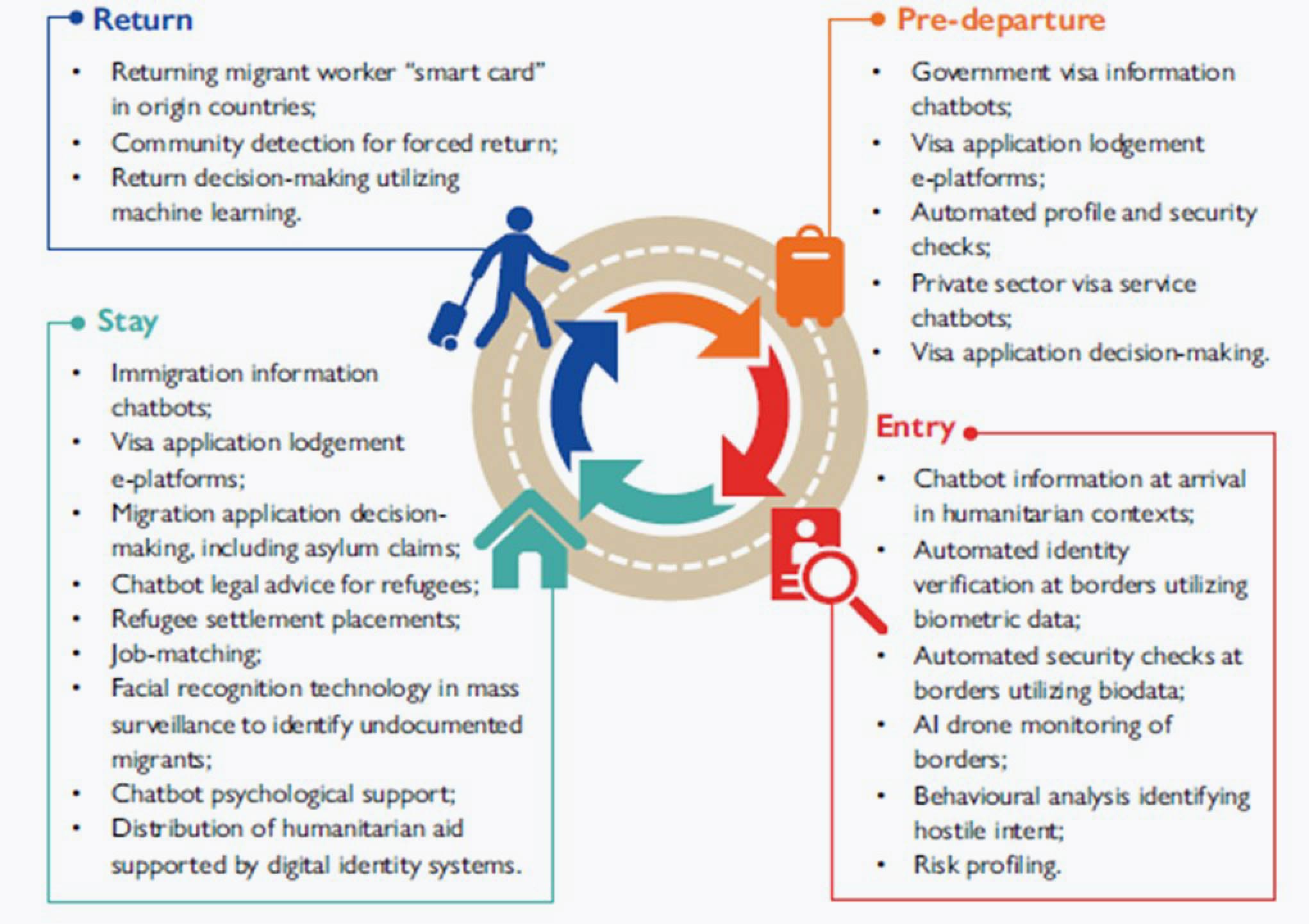Digital technology and migration
What is digital technology?
The concept of digital technology has historically been closely related to computer technology, and in particular advances in computerisation and increasing reliance on computers in human and machine labour from the mid-twentieth century onwards. However, digital technology is broader, encompassing computer technology and non-computer technological innovations, such as those associated with smart phones and other devices. Related, digitalisation involves the creation of digital records or versions of all sorts of materials, such as paper/electronic documents and other information, photos, videos, music and other audio, biometric scans/imagery. [Excerpt from Chapter 1 “International migration and digital technology: An overview” by Dr. Marie McAuliffe in the Research Handbook on International Migration and Digital Technology]
Digitalisation of telecommunications over the last century
The rise and expansion of digital technology is a characteristic of the Fourth Industrial Revolution “velocity, scope, and systems impact” that is deeply transforming the way we live.
Earlier industrial revolutions relate to advances in the use of steam/water for mechanization (1700s), electricity for mass production (1800s), early computers for early digitalisation (from 1950s).
International migration as a growing phenomenon in recent years and decades, is increasingly affected by digitalization processes and related technological advances. the last century. (See textbox from WMR 2018)
- 1930s Invention of the modern computer
- 1960s E-mail entering use
- 1980s Cell phones introduced to the public
- 1983 GPS made available for public use
- 1989 Invention of the World Wide Web
- 1993 Internet is shared in the public domain
- 1994 Start of blogs and social networks
- 2001 Start of 3G smart phones
- 2004 Facebook is launched
- 2006 Twitter is launched
- 2007 Cloud computing; first iPhone launched
- 2009 Start of 4G smart phones
- 2010 First iPad; rapid growth of tablet usage
- 2018 Start of 5G technology
In 2019 digitalization was estimated to have resulted in:
- 500 million tweets
- 294 billion emails
- 4 petabytes of data created on Facebook
- 4 terabytes of data created by connected cars
- 65 billion messages on WhatsApp
- 5 billion searches made
Key resources on the topic
- Artificial Intelligence, migration and mobility (WMR 2022, Ch. 11)
- Inclusion and social cohesion (WMR 2018, Ch. 6)
- Research Handbook on International Migration and Digital Technology
Digitalisation and migration
Digital technology is increasingly used throughout the ‘migration cycle’
- Pre-departure: migrant decision making and preparation; visa information (e.g chatbots); visa application processing/e-lodgement; risk profiling
- Entry: passport/visa technologies; border technologies (e.g. drones); biometric/identity related capture; behavioural risk analysis; apps to facilitate movement by migrants
- Stay: connectivity to support transnational families (e.g. ICT apps, mobile money); integration services (e.g. online, apps, chatbots), international advocacy (e.g. human rights’ groups)
- Return and reintegration: return migration analysis & assistance (e.g. ‘smart cards’); data dossiers on undocumented migrants
- Migration, technology and public debates: Mis- and disinformation
- Analysing migration dynamics: digital technology in migration research and analysis
How are digitalization and artificial intelligence (AI) related?
AI technologies rely on underlying data capture and digital capabilities in order to be applied. “Digitalization” of aspects of migration systems is, therefore, a necessary condition for the application of AI technologies. However, digitalization does not necessarily result in AI technologies being developed and implemented. Compared with digitalization, AI in migration and mobility is currently much more limited.
Artificial intelligence throughout the migration cycle

Artificial intelligence throughout the migration cycle
Challenges and opportunities Technology may enable capabilities and function as an equalizer of societal disparity. For example, digital identity initiatives may provide excluded individuals, such as migrants and refugees who cannot prove legal identity, with the means to open a bank account and access a variety of services in a host country. The increasing datafication of migration and mobility can create and magnify vulnerabilities. Datafication refers to the different types of data, including biometric, satellite and big data, which are increasingly collected, stored and used for migration management. Poor data storage practices and cybersecurity flaws can expose migrants’ sensitive information. There are advantages in using AI in the context of border security and migration management. AI systems can analyse vast amounts of data, including big data, to identify patterns and predict behaviour. AI algorithms can thus increase efficiency by streamlining repetitive tasks that depend on the review of large amounts of data. AI technologies are frequently used for visa and asylum processing and decision-making. A key advantage of using AI systems is that they can speed up visa and asylum application processing while screening for security threats and reducing irregular migration. AI systems can however amplify existing human biases, not just encode them. This can ultimately lead to discrimination and exclusion of people based on protected characteristics, including race and ethnicity. Bias is a common issue that permeates AI systems in a variety of sectors. Therefore, AI systems need to be developed in a way that deliberately and systematically seeks to remove or reduce bias throughout the process, from data collection and analysis to the reporting and assessment stages. One of the key aspects currently underpinning analysis is the extent to which a lack of transparency dominates. To some extent, this is likely to be fuelled by the risk of malicious acts of cybersecurity to undermine or control AI systems. However, this in itself creates different risks, especially as they relate to the erosion of human rights.
Reflection questions
What does the fourth industrial revolution refer to?
Describe how digitalisation impacts migrants throughout the migration cycle. Please provide two examples.
Briefly explain two reasons why digital technology and AI in migration processes raises concern.